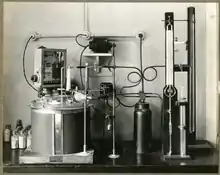Hygroscopy
Hygroscopy is the phenomenon of attracting and holding water molecules via either absorption or adsorption from the surrounding environment, which is usually at normal or room temperature. If water molecules become suspended among the substance's molecules, adsorbing substances can become physically changed, e.g., changing in volume, boiling point, viscosity or some other physical characteristic or property of the substance.

Etymology and pronunciation
The word hygroscopy (/haɪˈɡrɒskəpi/) uses combining forms of hygro- and -scopy. Unlike any other -scopy word, it no longer refers to a viewing or imaging mode. It did begin that way, with the word hygroscope referring in the 1790s to measuring devices for humidity level. These hygroscopes used materials, such as certain animal hairs, that appreciably changed shape and size when they became damp. Such materials were then said to be hygroscopic because they were suitable for making a hygroscope. Eventually, though, the word hygroscope ceased to be used for any such instrument in modern usage. But the word hygroscopic (tending to retain moisture) lived on, and thus also hygroscopy (the ability to do so). Nowadays an instrument for measuring humidity is called a hygrometer (hygro- + -meter).
Overview
Hygroscopic substances include cellulose fibers (such as cotton and paper), sugar, caramel, honey, glycerol, ethanol, wood, methanol, sulfuric acid, many fertilizer chemicals, many salts (like calcium chloride, bases like sodium hydroxide etc.), and a wide variety of other substances.[1]
If a compound dissolves in water, then it is considered to be hydrophilic.[2]
Zinc chloride and calcium chloride, as well as potassium hydroxide and sodium hydroxide (and many different salts), are so hygroscopic that they readily dissolve in the water they absorb: this property is called deliquescence. Not only is sulfuric acid hygroscopic in concentrated form but its solutions are hygroscopic down to concentrations of 10% v/v or below. A hygroscopic material will tend to become damp and cakey when exposed to moist air (such as the salt inside salt shakers during humid weather).
Because of their affinity for atmospheric moisture, hygroscopic materials might require storage in sealed containers. When added to foods or other materials for the express purpose of maintaining moisture content, such substances are known as humectants.
Materials and compounds exhibit different hygroscopic properties, and this difference can lead to detrimental effects, such as stress concentration in composite materials. The volume of a particular material or compound is affected by ambient moisture and may be considered its coefficient of hygroscopic expansion (CHE) (also referred to as CME, or coefficient of moisture expansion) or coefficient of hygroscopic contraction (CHC)—the difference between the two terms being a difference in sign convention.
Differences in hygroscopy can be observed in plastic-laminated paperback book covers—often, in a suddenly moist environment, the book cover will curl away from the rest of the book. The unlaminated side of the cover absorbs more moisture than the laminated side and increases in area, causing a stress that curls the cover toward the laminated side. This is similar to the function of a thermostat's bimetallic strip. Inexpensive dial-type hygrometers make use of this principle using a coiled strip. Deliquescence is the process by which a substance absorbs moisture from the atmosphere until it dissolves in the absorbed water and forms a solution. Deliquescence occurs when the vapour pressure of the solution that is formed is less than the partial pressure of water vapour in the air.
While some similar forces are at work here, it is different from capillary attraction, a process where glass or other solid substances attract water, but are not changed in the process (e.g., water molecules do not become suspended between the glass molecules).
Engineering properties
The amount of moisture held by hygroscopic materials is usually proportional to the relative humidity. Tables containing this information can be found in many engineering handbooks and is also available from suppliers of various materials and chemicals.
Hygroscopy also plays an important role in the engineering of plastic materials. Some plastics are hygroscopic while others are not.
Biology

The seeds of some grasses have hygroscopic extensions that bend with changes in humidity, enabling them to disperse over the ground. An example is Needle-and-Thread, Hesperostipa comata.[3] Each seed has an awn that twists several turns when the seed is released. Increased moisture causes it to untwist, and, upon drying, to twist again, thereby drilling the seed into the ground.
Thorny dragons collect moisture in the dry desert via nighttime condensation of dew that forms on their skin and is channeled to their mouths in hygroscopic grooves between the spines of their skin. Water also collects in these grooves when it rains. Capillary action allows the lizard to suck in water from all over its body.
Deliquescence
Deliquescence, like hygroscopy, is also characterized by a strong affinity for water and tendency to absorb moisture from the atmosphere if exposed to it. Unlike hygroscopy, however, deliquescence involves absorbing sufficient water to form an aqueous solution. Most deliquescent materials are salts, including calcium chloride, magnesium chloride, zinc chloride, ferric chloride, carnallite, potassium carbonate, potassium phosphate, ferric ammonium citrate, ammonium nitrate, potassium hydroxide, and sodium hydroxide. Owing to their very high affinity for water, these substances are often used as desiccants, also an application for concentrated sulfuric and phosphoric acids. Some deliquescent compounds are used in the chemical industry to remove water produced by chemical reactions (see Drying tube).[4]
Polymers
Many engineering polymers are hygroscopic, including nylon, ABS, polycarbonate, cellulose, and poly(methyl methacrylate).
Other polymers, such as polyethylene and polystyrene, do not normally absorb much moisture, but are able to carry significant moisture on their surface when exposed to liquid water.[5]
Type-6 nylon can absorb up to 9.5% of its weight in moisture.[6]
Applications in baking
The use of different substances' hygroscopic properties in baking are often used to achieve differences in moisture content and, hence, crispiness. Different varieties of sugars are used in different quantities to produce a crunchy, crisp biscuit (US: cookie) versus a soft, chewy cake. Sugars such as honey, brown sugar, and molasses are examples of sweeteners used to create more moist, chewy cakes.[7]
References
- "Hygroscopic compounds". hygroscopiccycle.com. IBERGY. Retrieved April 7, 2017.
- "IUPAC - hydrophilic (H02906)". goldbook.iupac.org. doi:10.1351/goldbook.h02906. Retrieved 2019-09-09.
- Fire Effects Information System, Species: Hesperostipa comata U.S. Department of Agriculture Forest Service.
- Wells, Mickey; Wood, Daniel; Sanftleben, Ronald; Shaw, Kelley; Hottovy, Jeff; Weber, Thomas; Geoffroy, Jean-Marie; Alkire, Todd; Emptage; Sarabia, Rafael (June 1997). "Potassium carbonate as a desiccant in effervescent tablets". International Journal of Pharmaceutics. 152 (2): 227–235. doi:10.1016/S0378-5173(97)00093-8.
- Schwartz, S., Goodman, S. (1982). Plastics Materials and Processes, Van Nostrand Reinhold Company Inc. ISBN 0-442-22777-9, p.547
- "NYLON". sdplastics.com. San Diego Plastics, Inc. Retrieved April 7, 2017.
- Sloane, T. O'Conor. Facts Worth Knowing Selected Mainly from the Scientific American for Household, Workshop, and Farm Embracing Practical and Useful Information for Every Branch of Industry. Hartford: S. S. Scranton and Co. 1895.
External links
| Look up hygroscopy or hygroscopic in Wiktionary, the free dictionary. |